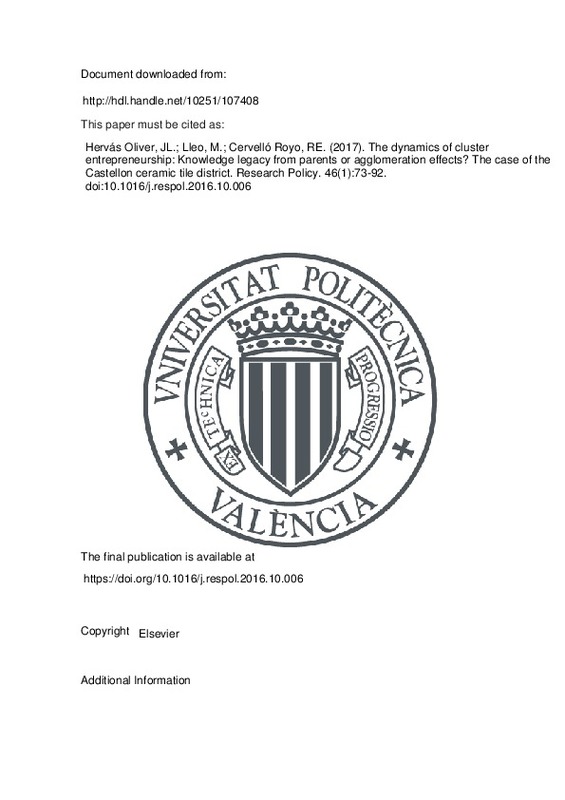JavaScript is disabled for your browser. Some features of this site may not work without it.
Buscar en RiuNet
Listar
Mi cuenta
Estadísticas
Ayuda RiuNet
Admin. UPV
The dynamics of cluster entrepreneurship: Knowledge legacy from parents or agglomeration effects? The case of the Castellon ceramic tile district
Mostrar el registro sencillo del ítem
Ficheros en el ítem
| dc.contributor.author | Hervás Oliver, Jose Luis
|
es_ES |
| dc.contributor.author | Lleo, María
|
es_ES |
| dc.contributor.author | Cervelló Royo, Roberto Elías
|
es_ES |
| dc.date.accessioned | 2018-09-17T07:36:08Z | |
| dc.date.available | 2018-09-17T07:36:08Z | |
| dc.date.issued | 2017 | es_ES |
| dc.identifier.issn | 0048-7333 | es_ES |
| dc.identifier.uri | http://hdl.handle.net/10251/107408 | |
| dc.description.abstract | [EN] What are the main mechanisms driving the process of industry clustering? There is a tension between two different perspectives as regards explaining entrepreneurship and spatial concentration: the roles played by agglomeration economies and knowledge legacies passed on from parents to spawns or spinoffs. Using qualitative interviews and archival data analysis, this paper tracks the evolution and the organizational reproduction of the ceramic tile cluster of Castellon (Spain) since its inception in 1727. Results show the existence of agglomeration and socially-based co-operation forces. Beyond de novo spinoffs, abundant social capital in highly agglomerated regions facilitates co-operation and new firm formation, and even co-operation amongst competitors to create new firms. Socially-based networks, reinforced by agglomeration externalities, all act as learning mechanisms to build pre-entry capabilities in new ventures, complementing Klepper¿s inheritance perspective. Spatial concentration of an industry can be attributed to the benefits of agglomeration and socially-based co-operation, in combination with the influence of knowledge legacies in a complementary and synergistic process. Conclusions are framed within the knowledge spillover theory of entrepreneurship, shedding light on how entrepreneurship occurs in clusters. | es_ES |
| dc.description.sponsorship | We thank Editor Martin Kenney, David Audretsch and Guido Buenstorf for their fantastic and constructive comments. Jose-Luis Hervas-Oliver also thanks Fiorenza Belussi, Andrea Furlani and Roberto Grandinetti for their comments at the presentation in the Padova PhD course. Carlos Camahort and the Porcelanosa co-owner Maria Jose Soriano were both very helpful with data and insights, as well as ASCER (Michel Toumi). We are thankful to financial support from the Spanish Ministry of Economics (MINECO) under research grant ECO2015:63645-R (MINECO/FEDER) Open Innovation in Clusters. | es_ES |
| dc.language | Inglés | es_ES |
| dc.publisher | Elsevier | es_ES |
| dc.relation.ispartof | Research Policy | es_ES |
| dc.rights | Reserva de todos los derechos | es_ES |
| dc.subject | Industrial dynamics | es_ES |
| dc.subject | Industrial districts | es_ES |
| dc.subject | Spin-offs | es_ES |
| dc.subject | Agglomeration | es_ES |
| dc.subject | KSTE | es_ES |
| dc.subject | Networks | es_ES |
| dc.subject | Cluster evolution | es_ES |
| dc.subject.classification | ORGANIZACION DE EMPRESAS | es_ES |
| dc.subject.classification | ECONOMIA FINANCIERA Y CONTABILIDAD | es_ES |
| dc.title | The dynamics of cluster entrepreneurship: Knowledge legacy from parents or agglomeration effects? The case of the Castellon ceramic tile district | es_ES |
| dc.type | Artículo | es_ES |
| dc.identifier.doi | 10.1016/j.respol.2016.10.006 | es_ES |
| dc.relation.projectID | info:eu-repo/grantAgreement/MINECO//ECO2015-63645-R/ES/INNOVACION ABIERTA EN CLUSTERS: UN ENFOQUE DE CAPACIDADES PARA EXPLICAR LA FORMACION DE COMPETENCIAS EN EMPRESAS LOCALIZADAS Y LA EVOLUCION DE LOS CLUSTERS/ | es_ES |
| dc.rights.accessRights | Abierto | es_ES |
| dc.contributor.affiliation | Universitat Politècnica de València. Departamento de Organización de Empresas - Departament d'Organització d'Empreses | es_ES |
| dc.contributor.affiliation | Universitat Politècnica de València. Departamento de Economía y Ciencias Sociales - Departament d'Economia i Ciències Socials | es_ES |
| dc.description.bibliographicCitation | Hervás Oliver, JL.; Lleo, M.; Cervelló Royo, RE. (2017). The dynamics of cluster entrepreneurship: Knowledge legacy from parents or agglomeration effects? The case of the Castellon ceramic tile district. Research Policy. 46(1):73-92. https://doi.org/10.1016/j.respol.2016.10.006 | es_ES |
| dc.description.accrualMethod | S | es_ES |
| dc.relation.publisherversion | https://doi.org/10.1016/j.respol.2016.10.006 | es_ES |
| dc.description.upvformatpinicio | 73 | es_ES |
| dc.description.upvformatpfin | 92 | es_ES |
| dc.type.version | info:eu-repo/semantics/publishedVersion | es_ES |
| dc.description.volume | 46 | es_ES |
| dc.description.issue | 1 | es_ES |
| dc.relation.pasarela | S\348692 | es_ES |
| dc.contributor.funder | Ministerio de Economía, Industria y Competitividad | es_ES |







![[Cerrado]](/themes/UPV/images/candado.png)

